
This is part of a Pew Research Center series of reports exploring the behaviors, values and opinions of the teens and twenty-somethings that make up the Millennial Generation
Event: Video
Quiz: How Millennial Are You?
At a conference at the Newseum in Washington, D.C. on Wednesday, Feb. 24, 2010, Pew Research Center analysts and outside experts discussed research findings about the Millennial generation, the American teens and twenty-somethings now making the passage into adulthood. The last of three sessions addressed the question of whether Millennials, who rocked the vote in 2008, will show up at the polls this November and how they may shape the political landscape beyond?
Moderator:
Judy Woodruff, Senior Correspondent, PBS Newshour
Opening Presentation:
Scott Keeter, Director of Survey Research, Pew Research Center
Michael Dimock, Associate Director for Research, Pew Research Center for the People & the Press
Panelists:
Matt Bai, Contributing Politics Writer, The New York Times Magazine
Eli Pariser, Board President, MoveOn.org
Reihan Salam, Schwartz Fellow, New America Foundation, and co-author, “Grand New Party”
In the following excerpt, ellipses have been omitted to facilitate reading. Find full transcripts, including audience discussion, and video of the full event at Millennials video page.
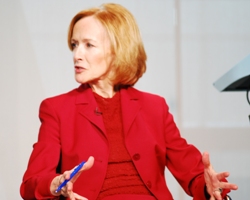
Judy Woodruff
JUDY WOODRUFF: Welcome back to our third and final panel of the day as we examine the younger generation born after 1980. This one is the panel most appropriate, I guess, for the city in which we meet, Washington, because it’s about how young people perceive politics and government, what their views are on the issues of the day and how they choose to engage in political life or not.
When I traveled around the United States in the midterm election year 2006 and again this year looking to see how the younger generation was being affected by the recession, and when I say this year I’m really talking about last 2009, I found some strong views. I found a surprising confidence and even a bit of wisdom. Here’s a minute’s worth of what we found.
(Begin video segment.)
Millennials Interviewee 1: We have to be wiser with our decisions in how we handle things with the economy, with energy, than previous generations have.
Millennials Interviewee 2: We grew up with things like “Will & Grace” and having that in the comfort of our home and so we’ve grown up with it. It’s been a part of our lives, and it’s not groundbreaking in the least bit to have interracial couples.
Millennials Interviewee 3: Our generation seriously thinks that no matter what comes to you there’s an answer to your problem.
(End video segment.)

Scott Keeter
SCOTT KEETER: First I’m going to start with something that isn’t news and that is that the Millennials made a big splash in 2008. According to the exit polls, the level of support for the Democratic candidate by young people — relative to the votes of everybody else — was greater; that disparity was greater in 2008 than it has even been in the history of exit polling. Sixty-six percent of the Millennial generation voted for Barack Obama in 2008 versus only about 53% of the voting public overall.
But even before 2008 the Millennials were looking like a very strong Democratic constituency. Fifty-four percent of them voted for John Kerry in 2004. That was his best age group, and 60% of them voted for Democratic candidates for Congress in the 2006 congressional elections. So one thing that we can take away from this is that while the Millennials really like Barack Obama, and they still like him, their impact on politics over the past several years was not just about Obama.
Now, aside from how they voted in these elections, another notable aspect was their level of engagement in terms of voter turnout. The gap between voter turnout between younger and older voters has been quite large over the past 30 or 40 years. The gap through this period at least since about 1980 has been quite sizable, 20 percentage points or more. And there was evidence going up to the 2000 election that this gap was actually getting wider rather than narrower. There was an uptick in voter turnout in the very engaging presidential election of 1992, but after that you really had a very wide gap reaching 25 points in the 2000 election.

[to]
Well, what is it that really accounts for this movement of young people toward the Democratic Party through this period as well as their high level of engagement in politics? As you’ve heard today, this is a very diverse generation racially and ethnically, and that of course matters politically because non-whites, as we’ve heard earlier, are more likely to vote Democratic. Just to give you a sense of how much the electorate of young people changed between 2000 and 2008, I have a couple of statistics from the exit polls.
In 2008, 62% of young voters were white, 18% of them were black; 14% were Hispanic and others of mixed race or other races. By comparison, 8 years earlier, nearly three-quarters of young voters were white, so from 74% in 2000 down to 62% white in 2008.
[taken]
We can do the same thing with generations. Because we’ve asked these questions 14 times since 1987 in exactly the same way, we can actually take the generations, not just the age groups but the people according to their birth cohorts, when they first appear in our survey, and then follow them over time in a process that’s called cohort analysis. That way we can see not only how a particular birth cohort is changing in response to the events of the moment, but then when a new cohort comes in we can see where they stand on these value questions compared with not only their elders at that point in time but also at earlier generations when they were the same ages.
Let me start with the area where I think we see the greatest difference between younger and older cohorts, and that’s on social and cultural values. Here we’re talking about questions relating to the acceptance of homosexuality, interracial dating, the expanded roles for women, immigrants and the like. And there are a lot of different questions that can go into this. This particular index has about five items.
So here are the trends. The first sort of yellowish line is the Silent Generation, the oldest of the cohorts that we’re tracking here. If I put the Greatest Generation, born even before the Silent Generation, up there, the line would be even higher. Now, on this particular chart, lines that are high on the page will be conservative social values, and as we add more lines you’ll see there is an increasing liberal trend.
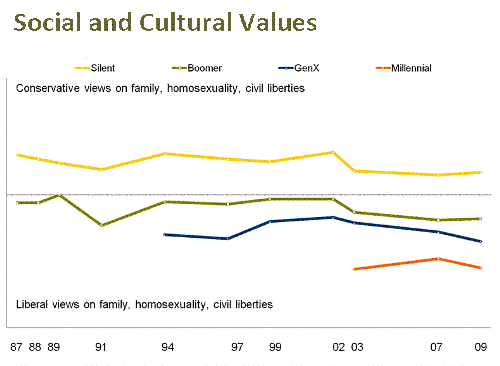
So this is the green line for the Baby Boomers. When we first started they were already fully established as a birth cohort in our surveys, and they were significantly less conservative than the Silent Generation, and also as you can see over time there hasn’t been a lot of change. In other words the line isn’t going up or down particularly. They’ve become a little more liberal but not a whole lot.
This is Generation X. When they first appear as a full birth cohort in 1994 they too are less conservative socially, and while there are some bumps up and down they continue to be distinctive from the other two cohorts. The Millennial generation is the orange line. They are by far the least socially conservative generation, and it looks like that pattern going to continue if what we’ve seen in the past bears up.
In another area, one that’s very important politically, we have a set of questions that tap attitudes about government, attitudes toward whether government should be doing more, whether government is inefficient and wasteful or does a better job than we generally think that it does, and on this one the higher lines are going to be the more liberal position.

[yellow line]
[The blue line is]
On some other issues that we’ve tracked we don’t see particular differences. For example, attitudes about business are not very different across the generations and don’t seem to be taking any particular tack. One of the oddest things I think from our work over the past few years is that even with the terrible recession and the fury that’s been aimed at Wall Street, general attitudes about business in our 2009 survey did not show a particular uptick in anti-business sentiment, and the same was true with the Millennials.
Similarly we don’t see very big differences among the generations in attitudes about the social safety net. One final one I’ll mention in which we have seen a little bit of a difference emerging this past year are attitudes about the use of military force. Young people have been showing somewhat greater reluctance to use military force. They are actually somewhat less satisfied with the way Obama is handling the situation in Afghanistan. They’re more opposed to the increase in troop levels there than other generations, but over time we haven’t seen a lot of differences on this particular set of value questions.
For a look at what’s happened to the Millennial generation and their attachment to the Democrats, I’ll hand the clicker over to my colleague Michael Dimock.
MICHAEL DIMOCK: We started this conference with Andy and Scott reminding us that this is a generation that’s already felt a little bit of political power and an influence in recent elections. Can Democrats count on that kind of support from this generation now and into the future?
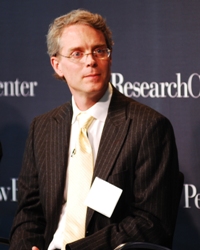
Michael Dimock
The suggestion from these slides Scott’s showing us is that these characteristics in terms of values tend to be sticky. In other words, while the mood of the public or the values of the public may ebb and flow toward government over time, the relative distance between generations tends to stay, and so the characteristics of this generation relative to others are likely to be robust.
That suggests that this is a generation that ought to be favorable to the Democrats now and into the future if those values differences do persist. But are they going to be able to hold onto 2-to-1margins like they had in 2008 and count on that from this generation as a voting bloc?
Let’s use 2008 as a jumping off point. I’ve taken a cross-section of the electorate in the year 2008 and the point of this is to show how distinctive the Millennials are. The Millennials are over on the left, and this is the balance of party identification in all of the polling that we conducted over the course of the year.

Among the Millennials, 62% either called themselves Democrats or leaned Democratic; 30% identify or lean Republican, mirroring of course the outcome of the election, a 2-to-1 margin for Barack Obama, and you see that’s pretty distinctive. The break points aren’t exactly along the generational lines that we’re using here for analytical purposes but quite distinctive from the other generations.
[I]
Gallup polls conducted in 1974 when these folks were in their 20s and late teens showed a 47%-to-17% Democratic advantage in identification. That’s even more overwhelming than what we’re seeing right now among the Millennials, not necessarily surprising given the circumstances and the context.
You still see some echo of that Democratic advantage in this group, but it’s certainly more muted than it was in the peak moment of 1974, and the question looking forward, I think, is 2008 a kind of peak moment like one that defines a generation, shapes a generation, but is it always going to remain that distinct and that separate from the rest of the population?
[I]

[B]
Already, 2009 has been a somewhat rougher year for Democrats in terms of their image. Obama’s ratings are down from what were potentially particular highs at the start of his presidency. What’s happened to the balance of party ID over the course of the past year is a convergence again, a kind of return to where we were in the earlier part of the 2000s, but that ebbing of Democratic fortunes, has been particularly notable among the Millennials themselves. The proportion of Millennials who identify or lean Democratic has fallen from 62% in 2008 as a whole to 54% in the fourth quarter of 2009.
To give more texture to this we’ve broken ’09 into quarters because really the Democratic losses started to take place in the later part of 2009 as a year. The percent identifying or leaning Republican has already bounced up from 30% in 2008 to 40% at the fourth quarter of 2009, and the thing to keep in mind behind all of this is that the values are likely stable.
We haven’t updated all the values trends every year, but the circumstances of 2008 were extreme. You had a change candidate who represented youthfulness and diversity by his very nature. You had an extremely unpopular incumbent president to younger people who rejected many of the things that George W. Bush stood for. That created an environment where young people could get mobilized.
The other thing that’s important to keep in mind behind this is I am tracking in these slides Democrats and Democratic leaners, and I’ve sort of blurred that distinction, but it’s not an irrelevant one. The plurality of young people are independents. When we say do you think of yourself as a Democrat, Republican, or independent, they’re saying independent by very wide margins. Now, that’s characteristic of youth. That’s not unusual.
But Democrats never really closed the deal with young people through this period. Even in 2008 young Millennials were no more likely to call themselves Democrats than any other generation. They were just more likely to lean Democratic than other generations. The erosion that you’re seeing here reflects that sort of lack of firm attachment to the party.
The counterpoint to that is the Republican Party, even though you’re seeing this 10-point rise here, that’s mostly a rise again in leaning, not people who right out of the gate call themselves Republicans. The Republican Party has had a very difficult time getting traction among this generation. Even in this fourth quarter of 2009, only 24% of the Millennials think of themselves as Republicans. That’s a very low number and hasn’t really come up even from 2008.
WOODRUFF: I want to pick up with this final question and turn to Eli Pariser, this notion that in less than a year, in the course of a year, that Democratic attraction has taken a dramatic hit. Does that square with your understanding of what’s happened, what you see and feel out there among grassroots supporters of MoveOn?
ELI PARISER: I’m not sure that the kind of allegiance to brands as a lifelong commitment in general is as true of this group as of previous groups. I think I would expect to see more variance and 2008 as a high point but a lot of variance in real time as people are adjusting to a very quickly changing world. I think there’s something real happening there. I also think that it may be less significant than it looks when you’re looking at other generations that changed much more slowly.
WOODRUFF: Reihan, from the perspective of conservatives, Republicans, the picture improved, but there’s still this reluctance to happily attach the label of Republican.
REIHAN SALAM: I think that the thing is these categories are actually quite unstable. They mean different things at different times, and I think that that’s the thing that I think of as most distinctive about this moment and also about this generation.
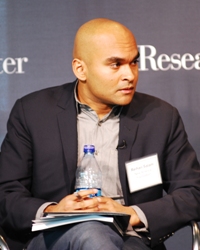
Reihan Salam
So you can have someone who described themselves as a diehard Democrat in 1974, Watergate baby, someone who kind of looked at the world in that particular way. Then when they were voting for Bill Clinton in 1992 this person was perhaps in a very different class position. They had a different mix of issues that they cared about, et cetera, and they lived in a different part of the country.
I think when you’re looking at these kind of broad contours of American ideological change, we talked about social liberalism and social conservatism and about how that’s changed over time. Well, you have lots of dispute about, for example, views on abortion and a lot of other little things like that.
One thing that you see though is that this generation considers those social issues somewhat less politically salient. They’re less intensive voting issues than they were for somewhat older folks and then also another thing to think about is are you a social liberal or a social conservative if you embrace the views of everyone who’s around you, your family, everyone in your neighborhood, everyone who kind of shares your broad sensibility.
What kind of impulse is that? We call that liberal because that way you’re both a liberal if you live in Austin, Texas or Sugarland, Texas if you have these particular sets of views. But in terms of your sensibility the way that you approach the world ,the way that you think about things, are you someone who actually breaks the mold, are you someone who is a contrarian by nature. It actually doesn’t tell you all that much, and I think that when you’re looking at our politics right now, the really interesting comparison is to a moment like the late ’60s.
[who]
When I think of MoveOn, I think of a group that actually is a funny mix of things. It’s a civil society group that is partisan in some respects, but it’s also a different kind of special interest group, and I think that they’re very explicit about that. And then when you look at what’s happening in the “tea party” movement, how do these guys feel about an issue like Afghanistan, how are they going to feel about an issue like that six months from now? If you think you know the answer to that, then you know a heck of a lot more than I do.
WOODRUFF: All right, Matt. We’re going to finally let you have a word here.
MATT BAI: I think when we talk about generational change — I’m not a social scientist so just looking at it from the sort of dumbed-down perspective of journalism — when you talk about generational change, it’s not a flip of a switch.
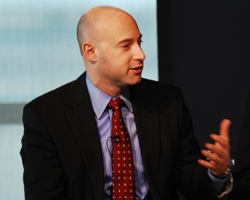
Matt Bai
It happens very gradually, and it permeates those boundaries. So I would submit that this president is actually on the leading edge. He appears older than I am. He just makes the boom, but nobody would really put him in that category. He’s on the leading edge of a much broader generational shift happening in the country that as you filter down to what we’re calling Millennials is much more distilled and apparent but is really happening from a much older age level down.
[T]
[I]
Daniel Pink the writer has called this the free agent nation. I think that’s a great term. I would actually say we’re a nation of comparative shoppers in a sneeze. That is the ethos of this generation and the generations to a certain extent that are older, so anybody who lives their lives online.
[T]
But whether or not that creates an institutional loyalty, I think it probably does not, and so I do think we’re going to have to have, as Reihan says, a faster movement of realignments, and it’s why Democrats who are shocked now say, wow, we had this 40 year realignment going in 2008. It was all set. I remember doing panels like this one where people said this is a Rooseveltian realignment, and two years later they can’t understand how they’re battling to keep the House.
It should show you the stupidity of making grand pronouncements because in fact our realignments aren’t going to be 40 years. They’re going to be 40 months if you’re super lucky, maybe 40 days, maybe 40 minutes depending on what’s happening on cable news.
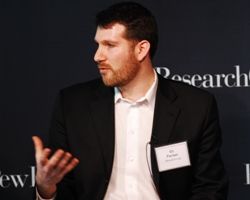
Eli Pariser
[P]
[how]
[needs to do]
PARISER: That’s right. I think Facebook White House, and actually they are trying to do this, and I think it does change — Barack Obama appears in my friend feed every six days and has a little pronouncement or something, and it’s interesting. It’s not quite right because I think the other piece is about authenticity, and I know that that’s some person in the DNC typing that in and not actually the president.
WOODRUFF: No!
PARISER: But actually in some ways false authenticity is worse than no authenticity, than just staying out of those spaces.
WOODRUFF: I think what a lot of people are interested in is getting at what is the sticky part of that, the Democrats. What is it that young people can be counted on to continue to like about what they see Democrats doing, and what is it that Republicans can come in, whether they’re leaning Republican or whatever, can come in and hope to pick off. Who wants to explore that a little bit?
[O]
[and was]
So you have this one political party that given its demographic balance is wracked by this kind of deep contradiction, and then you have another political party that is conservative in a subtly different but also important sense. The Democrats are very interested in kind of minimizing the kind of economic pain that you’re seeing over the course of this recession for lots of good and complicated reasons, whereas in the early 1980s, Reagan, who many people compare Obama to, made this very different deal. Reagan and Volcker basically kind of engineered an incredibly punishing recession that led to liquidation of a lot of sectors. But that was an era when you had lots of Americans who remembered the Depression or who remembered that in the early part of the ’50s or right after the war there was a very different period of some privation, tremendous anxiety, and a sense that you know what, this is something that can happen.
The Millennial generation hasn’t experienced a wrenching recession. I think that that creates kind of an affluence trap — people have too much to give up right now, particularly people who are under 30 who have no real subjective experience of what really wrenching economic change is like. I think that’s the reason why really big ticket dramatic reforms are just going to be very hard and will only happen when there’s a perception of real exigency.
BAI: I noticed another number in your report about Millennials feeling actually quite confident about their economic futures. Gary Hart, who I spent some time talking to for my next book, told me once that he thought in his worst moments — he feared it would take a depression to change the political dynamic that Reihan is talking about where we could get sort of broad changes to updating and changes to our social contract to our slate of policies.
[P]
[A]
PARISER: I also think it demonstrates how quickly things can shift that the Republican brand right now has actually managed to move itself already fairly far away from association with George Bush, even though I don’t think the policies have changed significantly, but the way people see those things has.
[I]
WOODRUFF: If social issues are not going to keep the Millennials connected to Democrats what would, and again I’m going to keep asking what’s the opening for Republicans to make headway.
[I]

Millennials, the Midterms and the Political Landscape Beyond Panel
PARISER: Part of what made 2008 a transcendent moment was it offered us a story about national meaning that resonated with this generation.
WOODRUFF: The story being the first African-American president?
PARISER: No, about rebirth and renewal, about building a stronger America, respect in the world —
DIMOCK: Working together, that was a big part of his theme too.
[Millennials]
Q: Bill Schneider: In the 1960s, China had a great proletarian cultural revolution. They got over it. In the 1960s, we had a great American cultural revolution, and we’ve never gotten over it, and we’ve been waiting for 40 years for the country to heal this red/blue divide that doesn’t seem to end. We’ve had three presidents in a row, each of whom promised to end the division: Clinton, Bush, the uniter not the divider, and now President Obama, and the division just keeps getting worse. My question is very simple. Do you from your data see any prospect that the younger generation will perpetuate this division or heal it?
[where]
[that]
Q: Matthew Continetti of the Weekly Standard. I’m fascinated by Gen X’s affinity to Ronald Reagan, and it seems to me that it was more a reaction to the failures of Reagan’s predecessors than it was perhaps a positive endorsement of the Reagan agenda. So there I think we could also perhaps draw a parallel to the Millennials’ enthusiasm for Barack Obama, maybe perhaps responding more to the failures of his predecessor than endorsing the agenda of the national Democratic Party.
DIMOCK: Yeah, I think so, and in that respect the longevity of that bubble depends on performance, as it often does in politics. If the affinities and affiliations we’ve seen in this generation now are to persist, they’ve got to see the payoff.
KEETER: There’s an interesting twist in the data that suggests that that possibility is still there, despite the bleakness of the party ID data for the Democrats, and that is while job approval for Obama among Millennials has dropped, they still approve of him at higher rates than do other generations. There’s been virtually no fall off in the favorability ratings of Obama as a person. So they still find him, presumably, to be an inspiring character and to embody things that they liked about him in the campaign, but they’re passing a negative judgment on his performance right now.
[not]
[Y]
[U]
Many of us in this room work for organizations that are funded by wealthy donors who are perfectly good people who want to do good for America, but at the same time, it’s all a way of shaping issue environments to reflect your kind of ideological beliefs. It’s a very complicated environment, and I think that that’s why it’s always going to tend toward 50-50 because whether it’s timber and mining and gas interests or it’s private insurers, the value of being able to control that regulatory apparatus is so powerful.
Scott earlier was talking about social issues have become less salient. Part of it is that given the composition of the Senate, given it’s not a one man, one vote institution, Democrats have to win some folks who are pro-life and who favored gun rights and what have you. So that actually constrains their ability to make some of those arguments, to make some of those claims, and again it’s because what is the efficient outcome in a competitive political marketplace.
[G]
SALAM: It’s funny because older hands say the exact opposite. They say that back in the old days when Washington legislators knew each other, they looked after each other’s kids, they loved each other. It’s funny. It’s a generational break how you look at that problem I think.
WOODRUFF: All right, question over here, let’s see, right there, all right, you get a second one Linda Wertheimer.
Q: Linda Werthheimer, NPR Senior National Correspondent. I do think that the red-blue divide is a structural question, but it’s not quite in the way that you framed it. I would say that it’s a question of how congressional districts are drawn, and as long as we have gerrymandering, we are not possibly going to mend any of this. It was possible not even very long ago for a real political tsunami to wash the Senate completely out and to substantially change the House. That’s not possible now. You can’t get that kind of flood now because so many of the seats are completely safe, and unless we all suddenly have some kind of mental breakdown and turn into Iowans, I don’t see how that changes.
[I]
Q: Maureen Wiebe with American Association of Christian Schools The research you’ve shared shows Millennials to be more liberal. But then if they’re more conservative on the abortion issue, I was just wondering if that was one of the issues included in your research and how that played out or affected your analysis.
KEETER: Abortion was not one of the questions in the values series that we’ve asked since 1987. So that’s not included. So when I was showing you the greater liberalism of young people it was not reflecting attitudes on abortion. It is true that there are very small or no generational differences on abortion questions, and that’s been true for a long time. There’s also been very little trend in attitudes about abortion.
Last year in a series of surveys that we did, we detected a slight uptick in conservative sentiment about abortion. But we also detected a small generational difference appearing for the first time, or let’s call it an age difference because we don’t know if it’s generational, in which young people actually were somewhat more pro-choice. Those data are included in the ninth chapter that deals with religion and values in the report, and you can take a look at them.
Download the full transcript (PDF) for more including additional audience discussion.




